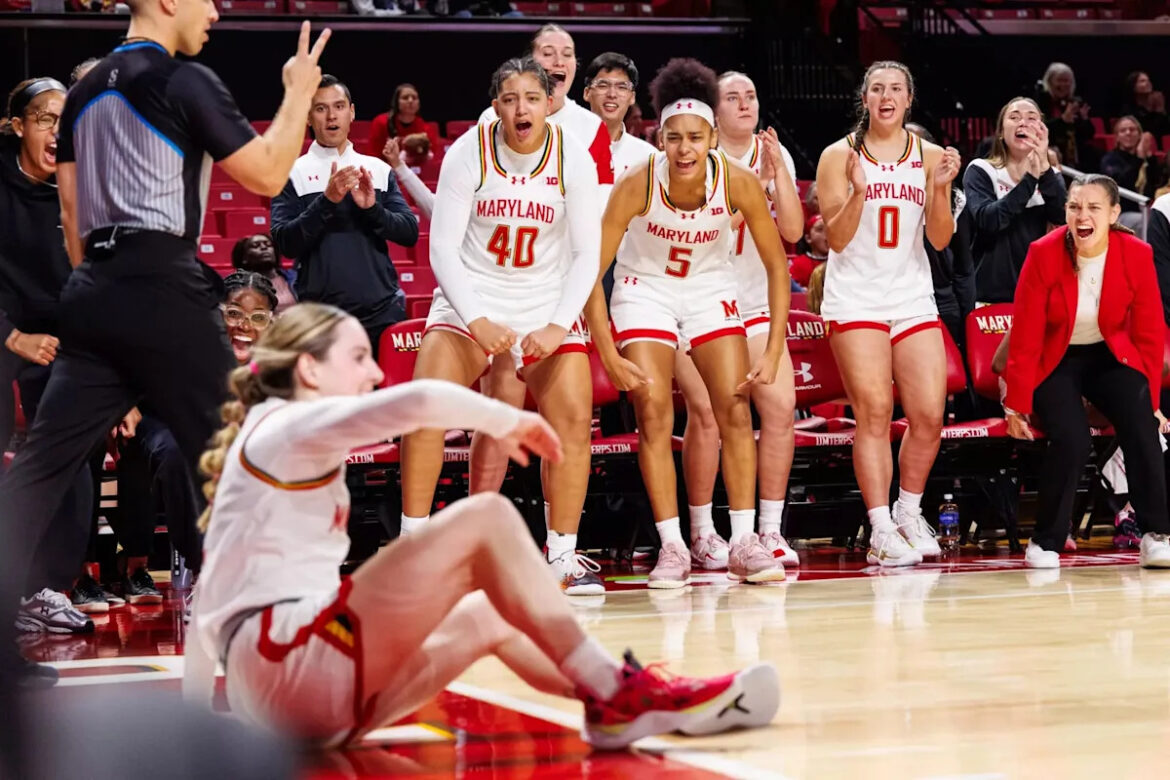No. 10 Maryland women’s basketball trailed by 10 with two minutes remaining in the third quarter on Sunday.
With its undefeated start to the season beginning to slip away, the Terps mounted a major late-game comeback to beat Georgetown, 85-66.
Advertisement
Here are three takeaways from Maryland’s win.
Addi Mack’s fourth-quarter takeover
That comeback for Maryland was fueled by an unlikely source.
Through the first three quarters on Sunday, Addi Mack played only nine minutes and was a relative non-factor after scoring six in the opening frame.
After head coach Brenda Frese called a timeout down by 10, she put Mack on the court, and the Terps began to come back.
Mack found another gear in the fourth quarter, where she scored 17 points on 7-of-9 shooting. The freshman guard drove into the paint, made layups and drew and-one opportunities. The Terps retook the lead with a 7-point run consisting solely of Mack’s layups.
Advertisement
“Addi, with her own 17 points single-handedly, put the team on her back — was just huge,” Frese said.
Throughout the entire game, Maryland lacked a primary scoring option. Sunday was the first time Maryland needed someone to step up and get the necessary buckets. In the absence of Kaylene Smikle and Bri McDaniel, Mack stepped up.
“It was still a close game coming into that fourth quarter. So I just wanted to come in, bring some energy,” she said.
Her contributions weren’t only visible in possession, either. Maryland turned defense into offense, pressing Georgetown into either bad shots or turnovers and transitioned it into layups.
Advertisement
“[Lea Bartelme, Oluchi Okananwa and I were] just getting steals. I mean, all three of us were up on that press, so it really kind of created a lot of energy for us,” Mack said.
Offensive rebounding
Maryland created second-chance opportunities that kept itself in the game, when trailing.
The Terps dominated the glass, finishing with 22 offensive rebounds to Georgetown’s 16 defensive rebounds. When Maryland struggled to shoot, the increased amount of offensive chances kept the deficit manageable.
“You can rebound every day. Like, no matter what, you can go and rebound,” Bartelme said. “Even if shots don’t go in, you have your teammates that it’s gonna be a rebound for you.”
Advertisement
Overall, Maryland had 18 more rebounds than the Hoyas. Saylor Poffebarger had 12 rebounds — all on the defensive end — which were crucial. But the offensive boards were more of a collective effort: four players had four or more offensive rebounds.
On several possessions throughout the comeback, Maryland missed its initial shot. On many occasions, the ball was tipped back out and the possession continued.
“Our guards got to do a better job of getting in there, rebounding and not tipping the basketball, hoping that somebody else is going to get it,” Georgetown head coach Darnell Haney said. “There were a couple of long rebounds that we should have got that we didn’t get.”
The Terps needed to face adversity
Through three quarters on Sunday, Maryland played poorly and under the standard set by Frese. After starting the game with a 9-0 run, the Terps trailed for the majority of Sunday.
Advertisement
The turnover bug was especially noticeable and has become an issue. The Terps committed 13 of their 17 turnovers in the first half, keeping Georgetown afloat and digging themselves into a hole.
“We needed to settle down at halftime. I thought we spent a lot of time kind of self-consumed on our own mistakes, and it was a pretty rough first half,” Frese said.
Maryland had to be resilient. Against a relatively weaker nonconference schedule, Maryland’s comeback could be beneficial later on.
The Terps don’t have many opportunities to be realistically tested until conference play. When Maryland eventually faces tougher opponents and finds itself in a hole, it won’t be something that it hasn’t faced.
Advertisement
On paper, Maryland would believe it is better than Georgetown and theoretically shouldn’t have trailed at any point. However, the Terps’ defense underperformed until dialing up pressure in the fourth quarter.
“Too many fouls and too many mistakes defensively, but we were able to clean that up at halftime,” Frese said. This team, when you tune them into anything, they want to respond, they want to make it right.”
The Terps eliminated mistakes and showcased their depth late. Frese is still trying to find out what lineups work in different scenarios, but what Maryland had in the fourth was a positive sign of things that could come.
“I thought we looked a little tired. Then that’s why I called the timeout to regroup us,” Frese said. “The press, I thought, single-handedly, that they really locked in.”
